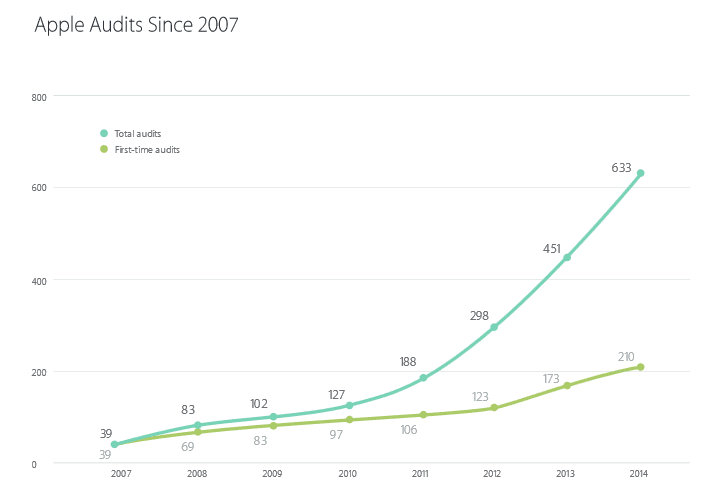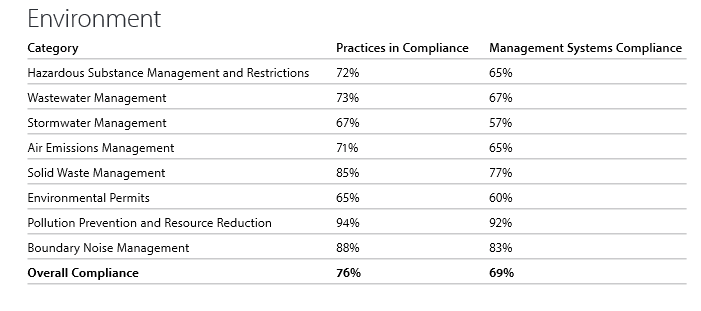Over the last four years, Apple's annual Supplier Responsibility report has really set the gold standard for sustainability reporting, offering an incredibly candid view of that is happening across Apple's vast supplier chain operations.
The new report for 2015 has just been released, and shows Apple continues to ramp up its supplier audit effort to unprecedented levels of activity.
Apple proclaims a deep concern about the welfare of the workers in its extended supply chain, noting that "While audits and corrective actions are essential, we believe the greatest opportunity for change comes from worker empowerment and education. In 2014, over 2.3 million workers were trained on our Code and their rights. We invested millions of dollars to expand our Supplier Employee Education and Development (SEED) program since it began. SEED now totals 48 classrooms in 23 facilities - equipped with iMac computers, iPad devices, education software, video conferencing systems, and more."
If a company is an Apple supplier, either directly or indirectly (i.e., a tier 1 supplier or further down the chain), it is subject to a detailed audit by Apple and its agents. All those suppliers must agree to meet the standards Apple has established its supplier code of conduct and its supplier responsibility standards. Those documents contain more than 100 pages of comprehensive requirements in 20 key areas, including labor and human rights, health and safety, environment, management systems, and ethics.
Apple has apparently been auditing its suppliers since 2007, but the practice really started to take off in 2011, at a period in which the electronics giant was facing sharp criticism that workers in its extended supply chain - notably at contract manufacturing giant Foxconn - were laboring under very poor working conditions.
In its 2011 "Supplier Responsibility Report," Apple was very candid about the shortcomings it faced in many areas of its supply chain, which we at the time said was going to set a new standard for such reporting.
Well, the 2015 Apple supplier report is here, and Apple has continued to up the ante in terms of such supplier analysis.
As can seen in the graphic below from the report, Apple conducted 633 supplier audits in 2014, up 42% from the 451 audits it conducted in 2013. That included 210 audits of supplier sites that had not been audited in the past.

Source: Applier Supplier Reort 2015
While most of the audits are scheduled, Apple conducted 40 surprise audits in 2014, where its teams visited suppliers on-the-spot and inspected the facility within hours.
These audits aren't trivial affairs. According to Apple, the process works like this:
1. Preparation: First, every new factory must follow Apple's Code and Standards, and agree to be audited. Audits are prioritized based on geographic risk, previous audit performance, commodity risks, and planned spending, as well as concerns brought to Apple by internal teams, external stakeholders, NGOs, and others.
2. On-site Audit: Every onsite audit is led by Apple auditors, and supported by local third-party auditors and experts who have been trained on Apple auditing protocols. Together those teams review hundreds of payroll documents, interview workers, physically assess the health and safety conditions of the facilities, and inspect the environmental conditions inside and outside the factory walls.
3. Corrective Action: Suppliers are required to remediate all violations. Every supplier must submit a Corrective Action Plan within two weeks of the audit, outlining a corrective course of action. Severe violations negatively affect the supplier's business relationship with Apple, including possible termination.
4. Monitor: A team of verification specialists works with suppliers, checking in at 30-, 60-, and 90-day intervals, to make sure they're on track. Any delayed progress is escalated to senior management.
5. Verify Remediation: Apple hires a third-party auditor to visit the facility at the 120-day mark to independently confirm that everything was resolved to its standards. If not, a second verification is scheduled within 30 days.
Apple notes it uses the scores from the audits as a key element of its supplier selection process. In 2014, the company reviewed 459 suppliers, and factored their responsibility performance into its buying decisions.
Apple goes even further, noting that suppliers often hire significantly more workers before new product launches, in some cases nearly doubling their work force.
"During this critical period of peak production known as ramp, we send a team on site to provide hands-on guidance to work with suppliers needing more help to address potential labor and human rights issues," Apple says in the report. "In 2014, we were on location, working together with suppliers who employed over 300,000 workers."
All of this of course adds a significant amount of expenses, but when you have iPhone level profits it apparently can be
managed.
Apple said serious violations where the supplier does not seem committed to fixing the issues can lead to termination of the relationship, and that under this program 18 suppliers have been forced out.
Also interesting is the impact of audits on future supplier performance. In 2014, facilities audited two times scored 25% higher than those facilities with first time audits. Facilities audited three times or more scored 31% higher than facilities audited for the first time.
Worker Education Major Part of Effort
Can Apple single handedly change the world? The company said under its auspices, Apple suppliers trained 2.3 million workers in 2014 - and more than 6.2 million since 2007 – relative to the Apple Code of Conduct, local laws, and health and safety regulations. Apple also provides educational resources to factory supervisors, training them on how best to communicate with their workers, uphold human resources policies, and maintain a safe workplace.
As part of our Supplier Employee Education and Development (SEED) program, Apple says it has invested millions of dollars to equip factories with computers, educational software, and video conferencing capabilities.
"We are committed to offering these courses for as many workers as possible - fully funded by Apple and the supplier," Apple says. In 2014, the SEED program expanded to five more supplier sites, now totaling 48 classrooms in 23 sites. SEED had over 379,000 participants in 2014 alone.
Apple is also trying to force an end to abusive programs relative to so-called recruitment fee, in which firms charge workers a substantial amount of money to secure a position in an Apple supplier factory, often to workers coming in from other countries and who thus start working already in debt.
Apple said it forced some of its suppliers to reimburse $3.96 million in excess recruitment fees to over 4500 foreign contractors in 2014, bringing the total reimbursements to $20.96 million to over 30,000 foreign contract workers since the program began in 2008.
To achieve this, Apple audited 100 percent of our top 200 facilities that were most at risk of hiring foreign workers, conducting nearly 70 bonded labor assessments.
On the environmental side, Apple highlighted the results below, showing the percent of supplier operations that were in compliance with various elements of its standards, and then if the company had effective "management systems" in place to well address each area.
Apple's Environmental Supplier Compliance Scorecard

There is a ton of additional detail – the full report can be accessed here: Apple Supplier Responsibility 2015 Progress Report
Any reaction to Apple's 2015 supplier report? Let us know your thoughts at the Feedback button below.

TheGreenSupplyChain.com is now Twittering! Follow us at www.twitter.com/greenscm
|